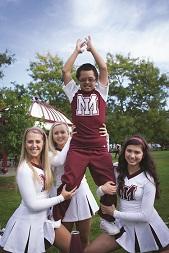

But the more cheer has evolved and changed, the more it has developed as a sport. It may look different across the United States, but it’s still entertaining and it’s still fun for both the athletes and spectators. We at the American Association of Cheerleading Coaches and Administrators (AACCA) have the responsibility of promoting safe and responsible student cheerleading. We also have a great vantage point for seeing some of the trends that are shaping the sport.

One trend that is changing the sport is the increased understanding of concussions. In all sports, coaches and administrators have become more aware of the dangers of concussions, and cheer is no different. Back in 2010, we released a “return to play” protocol, which established a progressive return to cheerleading participation for a cheerleader who has been diagnosed with a concussion. Our goal has been to minimize the occurrence of "Second Impact Syndrome" and allow the brain to heal before the athlete can return to full activity.
We have worked with the Centers for Disease Control (CDC) to document the real-life case of a cheerleader who was injured and didn’t receive proper diagnosis and treatment, and who as a result suffered cognitive problems. We want kids to know this doesn’t just happen to people in other sports; it’s something that could happen to themselves or to their friends. The point is not to scare them but to make them aware of the need to be safe.
We really take a 360-degree approach to safety. We’re not just concerned with concussions; we want to minimize overall risk. We now have access to more injury studies specific to cheerleading, and as a result, we have eliminated some maneuvers. One example is the double down – a stunt where a cheerleader is tossed, and goes through two full rotations in the air, then lands in the arms of other cheerleaders. That move is no longer allowed for cheerleaders of high school age or below.

Dance as a Competitive Sport
Dance and cheer are both very popular, and they continue to be so. It’s not uncommon for schools to have two separate squads, or for all-star programs to field teams in both disciplines. However, competitions usually will focus on one skill or the other, meaning that you’ll see competitions for either cheer or dance teams, rather than both.
 Just as there’s a lot of variety in cheer, there is a lot of variety in dance. You might see more lyrical dance, or a lot of hip-hop or jazz, or maybe a lot of precision dance. We’re also starting to see dance that requires partner skills. Of course, dance also has its skill levels and its safety restrictions. You don’t want people getting hurt.
Just as there’s a lot of variety in cheer, there is a lot of variety in dance. You might see more lyrical dance, or a lot of hip-hop or jazz, or maybe a lot of precision dance. We’re also starting to see dance that requires partner skills. Of course, dance also has its skill levels and its safety restrictions. You don’t want people getting hurt.
Programs for Athletes with Special Needs
One trend that we’re seeing – and we think it’s great – is special needs teams in cheer and dance. These are teams that include, or are made up of, kids who have developmental or physical disabilities, or both, and they can still be part of a program because the coaches have created routines that are safe and appropriate for them.
One example of a great program is The Sparkle Effect, which has been featured on Oprah and in a lot of other places. It was started by two girls on a high school team, one of whom had a brother who had disabilities. They said, ‘We are cheerleaders; we can do something here,’ and they started a team for special needs students. Now there is a website that includes a free start-up kit and grants for other kids who are interested in starting a program.
These days, you can find entire divisions for special needs teams in all-star programs and at various school levels. Many times, they will have kids from their other cheer or dance teams working with these special squads as assistant coaches. It’s really phenomenal.

The latest thing in cheer is the new discipline called STUNT. STUNT is strictly competitive, but it differs from what people have seen in cheer competitions. In cheer competitions, there may be any number of teams waiting to perform their routine, and each team will be on the floor for just a few minutes at a time.
By contrast, STUNT uses two teams only and it is a four-quarter, head-to-head competition between those two teams. The competition uses the skills found in cheerleading: partner stunts in the first quarter, pyramids and tosses in the second quarter, tumbling and jumps in the third quarter, and then in the fourth quarter, all those routines are performed back to back. Within each quarter, the teams will perform four 30-second routines based on that quarter’s focus.
 The key to the success of STUNT, which is growing really well on the college level and is spreading into other age groups, is that as a coach, you can match up your athletes with their special skills and let them excel in competition. You have a tumbling group, partner stunt groups, pyramid groups and so forth – and they’re still all part of the same team but they’re performing separately. You’re not trying to create one routine that will be okay for the athletes who, for example, are strong in tumbling but not good in partner stunts.
The key to the success of STUNT, which is growing really well on the college level and is spreading into other age groups, is that as a coach, you can match up your athletes with their special skills and let them excel in competition. You have a tumbling group, partner stunt groups, pyramid groups and so forth – and they’re still all part of the same team but they’re performing separately. You’re not trying to create one routine that will be okay for the athletes who, for example, are strong in tumbling but not good in partner stunts.
In STUNT, the routines are pre-set and so is the music; all of the music is provided free from the national headquarters. Both spectators and judges are able to watch two teams performing side by side, and see who executes the routine better. Points are awarded immediately after each quarter so the team standings are always changing. There’s a lot of excitement too; the match may come down to a sudden death overtime if you’re in the fourth quarter and two teams are tied.
STUNT is exciting to watch because it’s fast-paced (each quarter is only 15 minutes) and both teams are always out there, the way they would be if you were watching a basketball game or a football game. There is also a level of strategy involved since each round is scored separately and the team that is ahead each time gets to call the next routine and the skill level it will involve. It is literally a game-changer. We are seeing a lot of acceptance with STUNT and we are applying to have it named an Emerging Sport by the NCAA.
We expect cheer to keep evolving and we look forward to being a part of that evolution. It’s a great sport because there’s a wide range of skill le

vels involved and a wide range of places an athlete can fit in. It’s safer now than it ever was, too – and that’s really something to cheer about.

